1990
“Duality is the content and obsession of the great masks’ catalogue of Natalia LL. It signs the field of her author’s reflection penetrating the moment of unity, but always from a duality point of view (…)• For Natalia LL duality is a deep wound caused to the self by existence. Treating oppositions as something real, she copes with the problem of evil’s substantiality, of its demonical presence.” (fragments of Lech Karwowski introduction to the catalogue of Natalia LL exhibition in Szczecin)
“The changes in the creation of Natalia LL (…) confirm that this art has some constant references, the same threads, motives or ‘tropes’. The first trope — expressed through consciousness of her own body (…) we can name the trope of self. The other trope, dually completing the first, is the trope of consciousness of being — expressed through a deep reflection upon herself…” (frag¬ments of the text “Body and psyche” by Andrzej Saj in the catalogue of Natalia LL exhibition in Zamość).
Individual exhibitions:
— Panic Space, Centre for Art Promotion, BWA Lodz
— Painting-Sculpture-Installation, BWA Wrocław
— Painting-Sculpture-Installation, BWA Sopot
— Natalia LL: Painting-Photography-Installation, BWA Szczecin
Participation in exhibitions:
— Schnelle Bilder, Aktuelle Fotokunst im Gesprach, Kunstlerhaus, Wien
— 2X8: Aktuelle Fotokunst aus Polen und der DDR, Zentrutn fur Kunstausstellungen, Berlin
— 15th Festival of Polish Contemporary Painting: Crossroads of Painting, BWA Szczecin
— Part and Whole, Market Pavillon, Poznań

Plato’s form E, 1990
photocanvas and acrylic 130x105cm
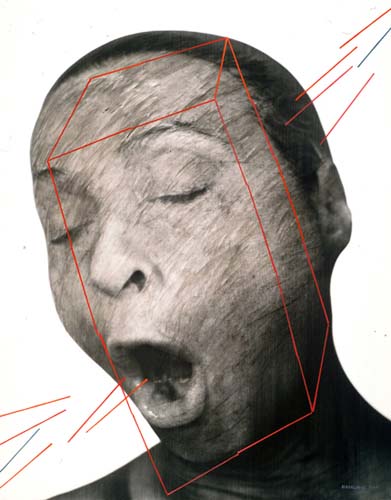
Plato’s form K, 1990
photocanvas and acrylic 130x105cm
1991
3-months stay in Austria on the schoolarschip of “Verein Kulturkontakte” in Wien. Writes the text “Theory of Head” (printed in “Exit”, no. 6,1991), where among others we read:
“This existential attitude is particularly dear to me when for reasons not fully known I have to pursue art. The force which makes me to do it is so overwhelming that there is nothing for it but to succumb to it with all humility. By this attitude I must show how important in art is the human head. What is meant here is the substantive contents of the head (brain) which Joseph Kosuth has shown with great expressiveness. Art proposed by Kosuth is a great glorification of the mind, i.e. that faculty of man which distinguishes him from others animals alive. Maybe for the first time in art history, conceptual art called out loud that it itself contains the criteria of art. It means that there is not much point in looking for these criteria outside art. If art is bound up with man’s mentality, it is the brain that must invent self-motivation (!) so that art should not be idle play or chewing gum for the eye.(…) I am fully and deeply convinced that the conceptual attitude is the greatest value we have brought and still can bring to art’s self-consciousness. Consequently, the art of our times can only be conceptual though bereft of orthodox and dogmatic purism.
The head is not only the stately home of the brain. It is also a creature with cavity that absorbs externality, namely different solid and liquid foods, smells and sounds. The ability to absorb external matter is the incredible secret of the head: the tenet that bread becomes flesh and wine blood is demonstrated here with great force. Without this tenet, the idea of Christianity would have been unthinkable. I envisaged the mystery of absorbing externality with such vividness that ever since 1972 all my art has been taken up with a conceptual play on consumption.(…)”
Individual exhibitions:
— Vision Space (installation: projection of the picture showing a head on the field of chairs covered with white cloth), Stara Gallery BWA, Lublin
— Natalia LL: Raum der Panik (installation), IFA Gallery Friedrichstrasse, Berlin
— performance “Europa” at the exhibition “Kunst/Europa”, Bonner Kunstyerein, Bonn
Participation in exhibitions:
— 1st Meeting of Active Art (installation: Vision Space), Wieża Ciśnień Gallery, BWA, Konin (text: Łazy Avant-garde)
— Passagen der Photographie: Aktuelle Photo-kunst aus Polen, Schloss Werkersdorff
— KUNST/EUROPA (installation: Panicky Sphere), Schloss Agustusburg, Bruehl
— New Spaces of Photography (installation: Gnothi Seauton), Museum of Architecture, Wrocław
— 20th Century Art Collection of Art Museum in Lodz, CBWA Warsaw
— 70 Jahre polnischer Photoavangarde, Kultur-form, Rheine
— Individual Art or Republic of Independent Artists, Centre for Contemporary Art, Warsaw
— Polish Women-artists, National Museum, Warsaw
— 19th International Biennial of Graphic Art, Modernę Galerija, Ljubljana
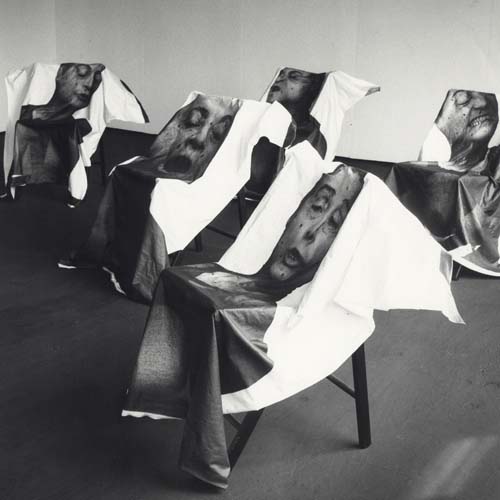
Panicky sphere, 1991
installation, IFA Galerie Friedrichstrasse, Berlin
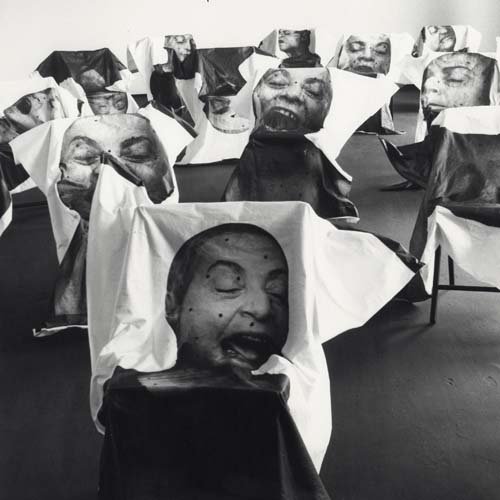
Panicky sphere, 1991
installation, IFA Galerie Friedrichstrasse, Berlin
1992
Individual exhibitions:
— Alpha and Omega (installation), Tower of Witches Gallery, BWA Słupsk
— Natalia LL, International Cultural Centre, Cracow
Participation in exhibitions:
— Presence III: 7X1, BWA Poznań
— 19 x 1: Women in the collection of National Museum in Poznań, Ethnographical Museum in Poznań
— Art Museum in Lódź: Collection-Documentation-Actuality, Musee d’Art Contemporain, Lyons
— Great Jubilee Painting Salon, BWA Cracow
— PERMAFO Gallery Documentation, Centre for Contemporary Art, Warsaw
— Mittel Europa: Fin de Siecles, La Grande Halle-la Villette, Paris
1993
Individual exhibitions:
– „Platonic Forms”, Galeria Sztuki Współczesnej BWA, Sandomierz
“A surplus of meanings, often questioning or even cancelling out each other, an individual character and reserve, irony are characteristics co-existing in Natalia LL’s series of pictures and installations done in the eighties. The artist combines in them what seems to be discordant. She shows that an object or a situation is this and the same time something else. So it may be assumed that in the last decade Natalia LL fulfilled her postulates dating from the mid- seventies, contriving to bring about a meeting of elements from the world of matter and the world of idea, elements which do not fit to each other, diverge, and at the same interact upon one another.” (fragment of the text by Grzegorz Sztabiński in the catalogue of Natalia LL exhibition).
– „Natalia LL: Art and Energy”, Muzeum Narodowe in Wrocław
The exhibition of photocanvas, sculptures, installations and video works made in the last years with the catalogue reviewing all output of the artist.
The authors of critical texts in the catalogue pointed especially at growing number of dramatic accents in Natalia LL works since late sixties. Bożena Kowalska concluded that the artist’s great sense of corporality resulted in her occupation with problems of body impermanence. Piotr Krakowski stated that Natalia LL’s self-portraits, painterly or photographic, produce an effect of double alienation manifesting in a specific mood and symbolism. The new series of her works – as he wrote – „make an impact with their ambiguity, they provoke and at the same time they reconcile discrepancies, keep their distance, are ironic and allusive, while at the same time very serious, they embrace reality and fiction, literality and poetry.”
Comparing earlier and latest works of the artist, Reinhold Misselbeck wrote:
“ Consumption Art and Dreaming provoke erotic associations in viewer’s mind, which faced with photographic fictions have to stay unfulfilled, while memento mori of deadly faces assures the fulfilment of this forecast. Seeing eye leaves a viewer to himself and reminds him of the act of temptation. Beauty stays unattainable, death sure. For Natalia LL, conscious seeing becomes a transcendental glance.” Also, Adam Sobota in his critical essay pointed out, that the common trait of Natalia LL works is the meaning of body existence; the artist in a symbolic way constantly marks its presence through photography, casts or traces of gestures. She seems to assume, that in the same way as complexity of psyche manifests itself through different emotional states, the sense of body existence can be expressed by the way of various aesthetical presentations.
The artist realized the series of sessions under the title “The Witch”, where she posed against an exuberant nature in the disguise suggesting magical rites associated with forces of nature cult. They were recorded and than presented mainly as large format colour photographs.
Participation in exhibitions:
– „Skjulte Dimensioner Polsk Samtidsfotografi”, Musset for Fotokunst Odense, Dania; the next exposition in: Gentofte Kunstbibliotek, Copenhagen
– „Żywioły” (Elements), Państwowa Galeria Sztuki, Łódź; the next exposition in: Galeria Domu Artysty Plastyka, Warszawa
– „Transgresje II”, Muzeum Narodowe, Wrocław (installation Energy of space)
– 30 years of Osieki, 1965–1981, Exhibition – Document”, Muzeum Okręgowe in Koszalin
1994
Individual exhibition:
– „Painting and installations”, Muzeum Śląskie, Katowice
One of the installations named Between Brunhilda and Natalia had a form of a box, where walls from outside were covered with the copies of her early work showing the artist naked and playing a flute. Inside the box, her big self– portrait with two cats was placed, done in demonic style. Its small multiplied copies covered inside walls. Another version of such installation, named Anatomy of a Room was exposed next month on group exhibition “OIKOS”. In an identical box, there was TV set on a table, next to two wraths from anturium, and on it, two china figurines of cats. TV was showing a film from Dreams of Brunhilda performance, where Natalis LL in a stylized disguise of mythical heroine, among other things, destroys bananas, which as the theme are present in her work from the time of Consumption Art in 1972. Many themes connected with these installations are explained by the artist in the text published the following year.
Participation in exhibitions:
– „Europa – Europa” (Vanguard Art of 20th Century in Central and East Europe), Bundes Kunst und Ausstellung Halle, Bonn (works from the series of Consumer Art)
– „Ars Erotica“, Muzeum Narodowe w Warszawie (installation Common Objects)
– „Hautevolle“, Galerie Rähnitzgasse, Drezno (works from the series of Destructs and the installation with masks)
– „Mnemosyne“ , Palais im Grossen Garten, Dresden (the work referring to the form of Pascal Triangle)
– „Videoprzestrzenie / Videospaces“, Państwowa Galeria Sztuki, Sopot
– International Biennial of Art, New Delhi (installation Veraikons mounted with self-portraits on photocanvas freely cast on chairs)
– „OIKOS“, Muzeum Okręgowe, Bydgoszcz (installation Anatomy of a Room)
Moving flower, 1994 (excerpt)
Voracious cats, 1994 (excerpts)
Brunhild’s dreams, 1994
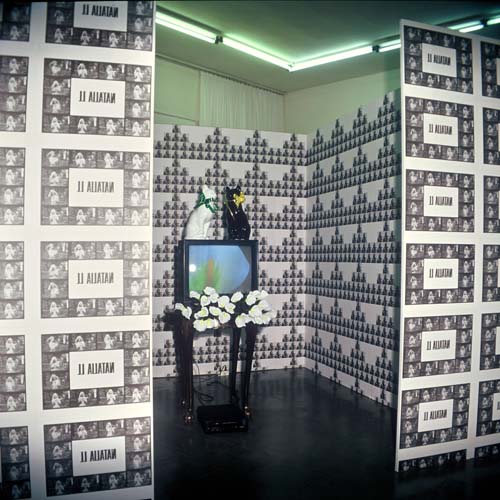
The anatomy of a room, 1994
installation, exhibition: OIKOS, Muzeum Okręgowe im. Leona Wyczółkowskiego, Bydgoszcz
1995
Individual exhibitions:
– „Przestrzeń aluzyjna“ (Allusive Space), Galeria Arsenał BWA, Białystok
– „Allusive Space“, Frauen Museum, Bonn
– „Powrót do źródła“ (Return to the Source), Muzeum Warmii i Mazur, Galeria Zamek, Reszel
– „Natalia LL“, Muzeum Okręgowe w Chełmie, Galeria 72, Chełm (works from the series of Consumer Art and Platonic Forms)
– „Nowe instalacje“ (New installations), Galeria Pusta, Górnośląskie Centrum Kultury, Katowice
– „Ogrody personalizmu“ (Gardens of Personalism), installation, performance and vernisage in the television studio TV5 in Wrocław
Participation in exhibitions:
– „Sztuka jako myśl – sztuka jako energia“ (Art as Thought – Art as Energy), International Drawing Triennale, Muzeum Architektury, Wrocław. A selection of works from the exhibition was presented also in Galeria Arsenał in Białymstok and in Muzeum Warmii i Mazur in Reszel
– „Mit Haut und Haar“ ( Marina Abramovic, Valie Export, Natalia LL, Friederike Pezold), Forum Schloss Platz, Aarau, Switzerland
– „Museum of Time Sign from the collection of Museum Modern Art in Hünfeld“, Galeria Awangarda BWA, Wrocław
– „Artyści polscy na festiwalach międzynarodowych 1975 – 1995“ (Polish Artists on International Art Festivals), Muzeum Narodowe, Wrocław
In the catalogue for the exhibition „New Installations” (Galeria Pusta, Katowice), Natalia LL published text entitled “Anatomy of a Room” which was a reflection on her childhood experience from time when she lived in Old Castle in Żywiec. In 1945, when Red Army was ousting Wermacht from Żywiec, a piece of bomb shell from a bomb dropped by soviet aircraft, flying next to her head destroyed two china figurines of cats and a bouquet of flowers. All this happened to the sound of Wagner’s opera music (Walkiria flight episode) played on a gramophone by a German soldier. In conclusion, Natalia LL stated, that the true winner of the war, which brought so many misfortunes, was Richard Wagner’s music, which survived extermination of mankind and material objects and is still a source of creative inspirations. This recurrent childhood memory caused, that in installations of Natalia LL started to appear music and motives from Wagner’s operas (the artist disguises herself as Brumhilda), as well as photographs of cats or their china figurines.
The notion of „allusive space” which since 1995 has often appeared in titles of Natalia LL installations’, refers to the possibility of associating many different meanings through several basic forms of profound symbolic power. These are images of such objects as human skull, banana, anturium flower, masks, warrior’s accessories, and first of all, images of her own face and whole body, replaced sometimes by models. Possible meanings – allusions – refer, both, to different life spheres in general aspect, as well as to different life periods in personal aspect. From above mentioned forms, the artist creates various entities, which, through multiplications, freely shape the space of exposition. Usually, these are repeatedly recurring photographic frames attached to long ribbons of fabric, which is shaped into waves, thrown over different objects, or take form of a specific figure, for example imitating rays of the Sun (as in exhibition “Allusive space” in Bonn).
Stefanie Bauman in her text of 1995 wrote that: „Natalia LL’s works are very personal. She is struggling in them with her own identity which finds its expression in body art, so typical of her and which she calls ‚the most honest method of artistic expression’, an art of being oneself. Indeed her works are deeply rooted in her very personal problems.“ Also Dušan Brozman in his text for the exhibition “Mit Haut und Haar“ in 1995 stressed, that artistic creation of Natalia LL focuses almost exclusively on her own full of eroticism image. Brozman located her method in the tradition rooted in Pop Art and Conceptualism and contrasted works of Natalia LL with those created by males exploring problems of consumption and eroticism in art. He pointed out to the fact, that Natalia LL undermined principles of some canon in presenting female, which was set up by earlier avant-garde artists. He also considered as important the context of socialist state in which early works of Natalia LL appeared. For this reason, her criticism of consumption and erotic hypocrisy, has additional value of irony and ambiguity. As he concluded: „Humour and sexual symbols should yet not make us blind for the fact, that female narcissist, Natalia LL, as well as her artistic comrade, Urs Lüthi, look with nostalgia towards paradise and death. What in the early days of their creativity was only a presage has been confirmed in both cases in later creation which shows passing away of body and beauty.“
In the interview which Natalia LL gave to Wiesława Wierzchowska concerning the theme of art and eroticism (in 1994, published in 1995), the artist stated, that her philosophy of eroticism is based on Platonic myth, saying that human being was once an entity. So in an erotic act, we return to it, and moreover, we can create new life. Eroticism contains in itself vitality and exultation, but creates also fear and suffering. Natalia LL stated, that she tried to explore this problem through philosophical, religious and literary works, as well as through analysis of her own feelings. Ambiguity of erotic sensations was expressed in works showing sexual contacts, consumption, different variations of self– portraits, in such a way, that they oscillated on the edge of pornography, exhibitionism, as well as banality. It was exemplified in the installation on exhibition “Ars Erotica”, where a bed, a table and chairs were covered with sheets of photographic fabric with black and white prints of sexual act.
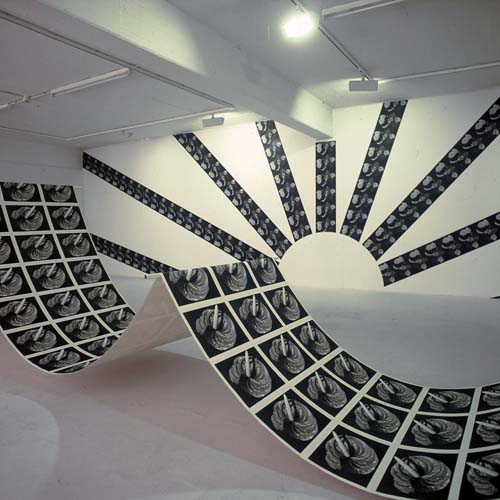
Allusive space, 1995
installation, Frauen Museum, Bonn

Skull I, 1995
print on canvas 30x30cm
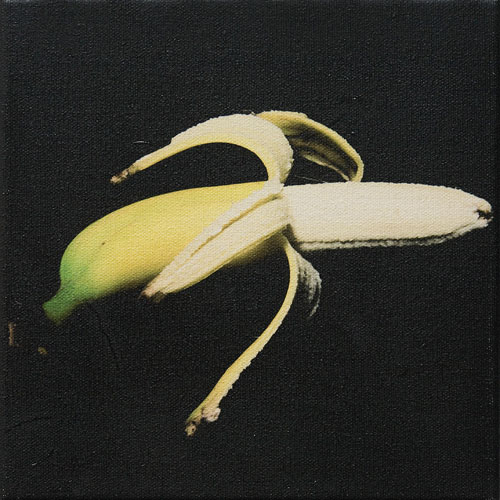
Banana I, 1995/2009
print on canvas 20x20cm
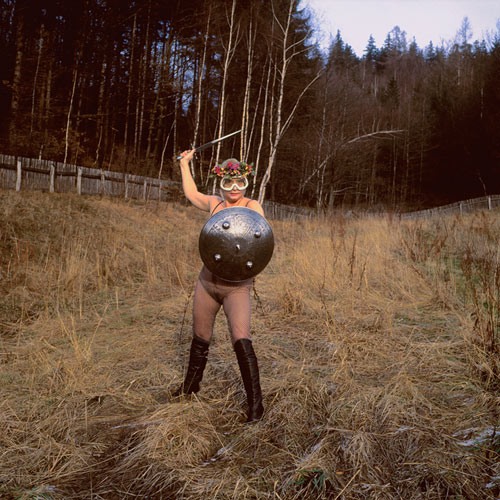
Performance „Brunhilda III”, 1995
photograph 100x100cm
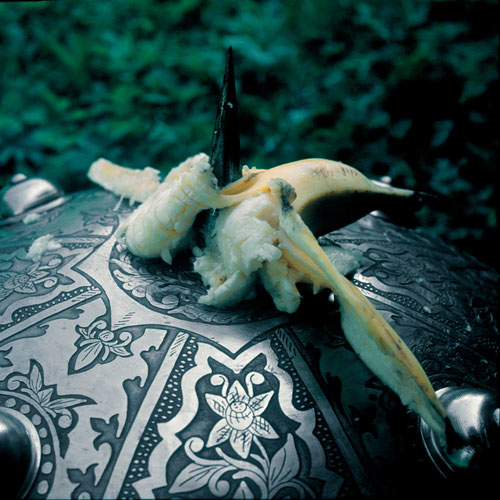
Shield, 1995
photograph 50x50cm
1996
In 1996 Natalia LL created the first works from the series Soul of Tree. They are colour photographs of tree trunks sections, as well as painting works, for which grinded sawdust was used. Their meaning is explained in the text of Natalia LL, published later. Observing how from a grinded willow tree new shoots begin to grow, she decided to use this mechanism in her art. By grinding these new shoots, she obtained powder that she used to create artworks, which in a symbolic way meant reaching the core of being, the soul of tree.
Individual exhibitions:
– “Hortus Eroticus”, Muzeum Okręgowe, Wałbrzych
– “Calamitas Calamitas”, Muzeum Ziemi Lubuskiej, Zielona Góra
(installation with metal waste mounted on platform slings, photographs and sculptures)
On that occasion Natalia LL wrote the text entitled „Calamitas Erotica“, published some time later. The artist states there: „I try to organize spaces which seem to ask questions, such as: what and who we are, and what is the driving force of our actions and activities. I must reject all of the altruistic platitudes, as it seems to me that we are driven by the energy of reproduction underpinned by eroticism.“ This eroticism she sees both as creative and destructive as her consciousness is overwhelmed by the excess of perceived existence aspects. As she concludes: „I built the truth on my own doubts and personal experiences. The inside becomes the outside, and this probably makes true art.“
Participation in exhibitions:
– „Body as Membrane“, Kunsthallen Brands Kaederfabrik, Odense, Dania; next shown at The Nordic Arts Centre, Helsinki (works of 17 women artists, among them: Valie Export, Mary Kelly, Orlan, Gina Pane, Carolee Schneemann. Natalia LL exhibited her works from the years 1978– 1987, which are photographic records of performances)
– „Despite / Difference – Polki“, Herbert Read Gallery, Canterbury
– „Kobieta o kobiecie“ (Woman about woman), Galeria Bielska, Bielsko– Biała (works of 25 polish women artists)
– „Artyści polscy dla Muzeum w Vukowarze“ (Polish artists for Vukowar Museum), Galeria Zachęta, Warszawa (works from the cycles Panic Heads and Vision Heads)
– „International exhibition – Action: Every Meter for Art“, Galeria Arsenał BWA, Białystok; shown also in Salzwedeler, Germany (drawings from the cycle The touch of the devil)
In his text for he catalogue of the exhibition „Body as membrane“ Adam Sobota pointed at the importance of how Natalia LL uses photography in her strategy of body art.
As he wrote, the question of when a living body represents art and when it is a common living organism is very similar to the question when photography is art and when it is just a reflection of the physical world. The body – like photography – represents the mysterious unity of material and spiritual functions. When we reflect on body – as well as on photography – we tend to take into account opposite qualities, analyzing both biological and technical rules, psychical reactions or abstract metaphysical notions. The author of the text also analyzed how Natalia LL uses the notion of space, calling it allusive, visionary, or panic. The state of panic in this case seems to be result of a tension occurring when existential contradictions are confronted, as they are essentially both unavoidable and impossible to be resolved. Panic is here an ultimate state of consciousness opposite to „States of concentration“ – as Natalia LL entitled her other works. So, from a certain point of view we may conclude that the differencies between these states are not vitally important for what we are actually dealing with is a process in whivh the various stages have been given different names. These names may be seen as conventional as far as one is able to preserve a sense of the essentials, which have no fixed form of expression as such.
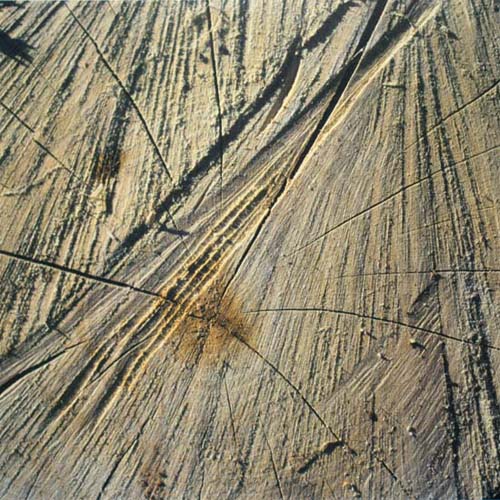
Spirit of the tree, 1996
cibachrome 125x125cm

Spirit of the tree, 1996
cibachrome 125x125cm
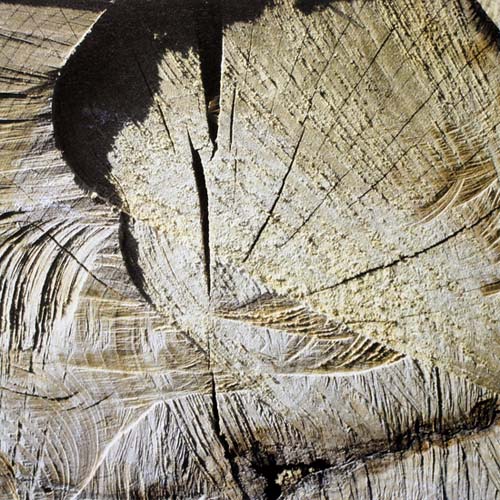
Spirit of the tree, 1996
cibachrome 125x125cm
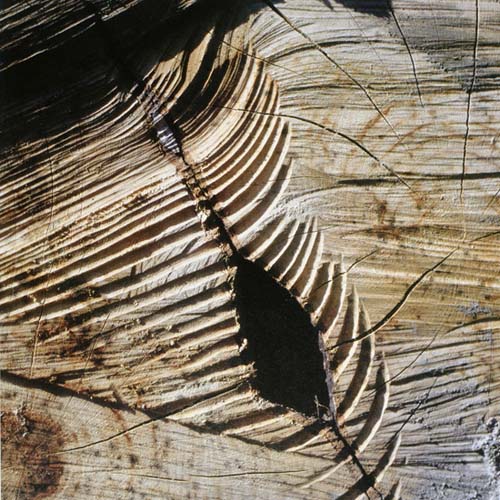
Spirit of the tree, 1996
cibachrome 270x270cm
1997
After the big flood that hit Wrocław and many regions of Silesia in July 1997, Natalia LL referred to this fact through the performance Menego on the bottom of dry reservoir of Bystrzyca river and through the concept of exhibition realized the following year. Menego is the title taken from prose of Cyprian Kamil Norwid and has a double meaning of sinking in water and sinking in banality of everyday existence. The artist pointed at Art as the protection against spiritual sinking. Photo and film recordings showed her lying naked on dry bottom of a lake, covered with dust of grinded wood.
Participation in exhibitions:
– „Artyści Wrocławia“ (Artists from Wrocław), Galeria Zachęta, Warszawa
– „Reflections on death – Death as an object in Art“, Miejska Galeria Sztuki, Częstochowa
– „Sources of Freedom“, Galeria Awangarda BWA, Wrocław
– „Photography ’97“, Fundacja Turleja, Pałac Sztuki, Kraków
– „Registractions and expressions. Photography Festival Spectrum“, Muzeum Narodowe, Wrocław
– „Collection for 1000 years of Gdańsk, Galeria Łaźnia, Gdańsk
– „Jeder Meter für die Kunst“, Rathausfoyer, Stadt Landshut; Kulturrathaus, Dresden
Two texts were written by Natalia LL explaining her attitude to photography and painting, the media which she treats at the same time complementary and contradictory. In the text Power of Painting she recollects, that in her early stage of creativity she was irritated by the powerlessness of painting, closed in a circle of conventional solutions, while photography seemed to offer much bigger possibilities. Later, however, she started to feel annoyed by limitations of photography. Here, she arrives to the conclusion, that: “Painting is a mature, professional and conscious realization, whereas the photograph and drawing are the records of the original and not–quite–conscious idea. It seems to me that the artistic reality can be recognized through a photograph or drawing, but only painting can reveal it fully and holistically, due to its age–old tradition, as well as mature and professional formalization of non–verbal content.”
On the other hand the text Aifargotof is her applause for photography potential. The crucial point for Natalia LL is that photography gives us an opportunity to reflect upon uncontrollable outer reality: “The photograph than, bears the hallmarks of my inner self and finiteness even though it records the outer world. […] it allows me to communicate with others with no fear of being swept away by the waterfall of the our world, or struck by the lightning and infinite energy of the Absolute.” The other important for the artist features is common accessibility of photographic code and its integrity with the media culture. She gives also an interesting thought about analogy between photography and music, as they both “are perfectly suited to the organs of hearing or vision and dependent on the inner need of man to segregate and systematize the signal”. She states there also that the system of digital recordings will push photography closer towards philosophy as each record to a greater extend will be of essential nature.
A study of Natalia LL’s creativity from the feminist standpoint was published, done by Agata Jakubowska (Woman as against sexuality – suppressed, entangled or liberated). The author of the text states, that the key to Natalia LL art is the presence of strongly accentuated eroticism, female sexuality. She points out, that the artist equals with male partner, and her erotic courage and activity is aimed against dominating position of male in traditional patriarchal model of culture, which dominates in art as well. As A. Jakubowska writes, female sexuality in art has became subdued to male perception, but there are ways to play with it, which Natalia LL uses in provocative manner. Yet we should notice that such emphasizing of combative feminist strategies in Natalia LL creativity, however right in many aspects, does not correlate with declarations of the artist, who sees the value of sexual sphere, first of all, in supplementation of female and male elements, and she also generally accepts traditional interpretation of eroticism, in the spirit of Plato’s philosophy and as seen by Christianity.
1998
Individual exhibitions:
– „Toniemy, to nie my, to niemy“, Galeria Awangarda BWA, Wrocław
– „Ogrody personalizmu“ (Gardens of Personalism), Centrum Sztuki Współczesnej – Zamek Ujazdowski, Warszawa (retrospective exhibition)
In both exhibitions can be traced catastrophic and eschatological trends, suggested, however, by experiences of current daily events, banal, as well as unusual (such as big flood from 1997). On the other hand, the artist used the method of integrated effect of ideas and images (like in visual poetry), constructing words out of photographic series, or forming geometrical shapes from letters of her name. In this way she referred to her works from early 70s, when she had simultaneously presented transformations of her name with printed series of film frames showing her in different situations. It resulted in many mysterious constructions balancing between a game with accidental arrangements and cabalistic ritual. In these works one might see relation to earlier series Platonic Forms, where ideal geometrical forms were pasted on an image of the author’s head.
Participation in exhibitions:
– „Body and the east“, Moderna Galerija, Lublana, Słowenia
– „Fields of Individuality“, Galeria Miejska Arsenał, Poznań
– „Galeria Ślad“, Centrum Sztuki Współczesnej – Zamek Ujazdowski, Warszawa
– Exhibition of the works given by the artists to the National Museum of Wrocław on the occasion of its 50th anniversary, Muzeum Narodowe, Wrocław

TONIEMY, TO NIE MY, TO NIEMY, 1998
installation, Galeria Awangarda BWA, Wrocław
1999
In the article about Natalia LL’s creativity – at the occasion of her exhibition Gardens of Personalism – Grzegorz Sztabiński pointed at the prominence of existential issues, which appear in her activities at different periods and in different artistic forms. The author of the article regarded the motion between categories of objectivism and illogical expression, or rationalism and biology, as extremely characteristic for Natalia LL. The artist, rather shows paradoxical presence of one category in the other, than counter– positions them.
Participation in exhibitions:
– „Without the Wall“, Marmorean Pallace, Russian Museum, St. Petersburg (installation of Veraikons)
– „Fotografia i przestrzeń“ (Photography and Space), Galeria FF, Łódź (installation of the works from the series Soul of a Tree)
– „Malarstwo 1999“ (Painting 1999), Galeria Stara BWA, Lublin (works from the series Soul of aTree)
– „International Performance – Trawnik ’99“, Muzeum Narodowe, Szczecin
– „Confronting Apocalypse – A kiss of death“, Galeria Bielska BWA, Bielsko– Biała (works from the series Down Tragedy)
– Berührungen – Tradition und Gegenwent Breslauer Fotografie, Galerie Lichtforum, Vienna
text: Adam Sobota